Care advice
When growing this flower variety, it is worth providing it with constant and thorough care. To do this, you must adhere to several rules.
Watering
Watering should be moderate, frequency - no more than 1 time in 1.5-2 weeks. More often, Marusya roses should be watered during flowering and growth - once a week (in summer), and once every 14 days in autumn.
This moment is the most important when caring for a plant, since a lack of moisture, like its excess, negatively affects the quality of the flower. With rare watering during growth, leaves begin to fall off the bush, the petals dry out, and the bush slows down the growth of shoots. If you neglect watering during flowering, the flowers grow small in size, with a pale color and less pronounced aroma.
After watering, it is better to overlay the ground around the bush with humus or spruce branches, as this helps to retain moisture for a longer time.
Top dressing
For the full growth and flowering of a rose, mineral fertilizers are needed, which must necessarily contain potassium, magnesium and phosphorus. And you should also use organic fertilizers, which are especially necessary during the period of flower growth.
The rose blooms twice, which is why you should pay attention to watering and feeding during these periods. Experts recommend using only mineral fertilizers during the first flowering, which falls on June-July. In this case, do not forget about abundant watering. During the second flowering, you can use a mixed fertilizer from mineral and organic fertilizing.
Pruning
Timely pruning of hybrid tea roses is of great importance in proper care. It can be of several types, depending on the strength of the pruning and on the season of its carrying out:
Weak pruning. The frozen or damaged tip of the shoot is cut off. After pruning, the rose begins to bloom early, there will be more flowers, however, the flowers themselves will be smaller.
Strong pruning. It is necessary to cut off more than half of the shoot, leaving 3-4 buds. The flowers will be larger, but there will be fewer of them. Flowering usually starts later than usual.
Pruning in the summer. It is carried out after flowering. Faded flowers are removed with a small part of the shoot
Such pruning will guarantee abundant flowering in the future.
Spring pruning is considered the most important. When the buds reach about 0.6 cm in size, it's time to prune, leaving 3-4 buds.
Autumn pruning
When preparing the plant for winter, it is necessary to remove all damaged and immature shoots. It is not recommended to cut the shoots too much, this can harm the plant during a harsh winter. The removed shoots are burned, since they may contain pest larvae.
Loosening the soil
In order for roses to bloom actively and be healthy, you need to carefully look after them, get rid of weeds. The soil is loosened to saturate the soil with oxygen.
The soil must retain moisture well, this will contribute to the normal development of the root system. The procedure is carried out after feeding or watering once a month.
Preparing for winter
Choosing the right time to prune and cover is an important step in preparing your tea rose for winter. If you cover the rose too early or dig in too early, the plant's immunity will weaken, it may die immediately after the first frost.
The longest shoots need to be cut, leaving only 6 buds so that the rose can grow again next year. The remaining shoots are carefully examined. If watery areas are found, they must be removed. After that, the rose is covered, buried in the surrounding earth, covering part of the stems and roots. The soil acts as a heat insulator, preventing the plant from freezing.
Additionally, it is necessary to cover the bases of the bushes with branches of pine trees, spruce branches, dry leaves. Sprinkle on top with peat 25 cm high. In severe winters, it is necessary to make a special frame on which to fix the insulating material.
Disease and pest control
Powdery mildew is the most common disease of hybrid tea varieties of roses. In order to prevent and prevent disease, it is necessary to treat the plants with baking soda.
It is necessary to dilute 40 g of soda in a liter of water, spray the leaves with the resulting solution. Do this in the spring when foliage appears. Spraying is carried out twice a week in spring and until the end of June.
Roses are often affected by green aphids. A soap solution with the addition of several branches of wormwood will help to cope with it.
A piece of laundry soap is rubbed into water (10 liters), boiled for 15 minutes, and infused. The solution is used to treat the stems and leaves of the plant. After a week, this procedure is repeated.
If the infection is very active and does not go away, it is worth turning to special chemicals that are sold in specialized stores.
The specifics of cultivation and agrotechnical recommendations
It is easier to create optimal conditions for damask beauties in the southern regions, however, gardeners in the middle lane, the Far East and Siberia also successfully grow them in their backyards and use them in the design of city parks. Cultivation on an industrial scale for the extraction of essential oil is not possible in most regions of Russia.
It is important to choose the right site for planting a perennial. The shrub grows best in draft-protected, well-lit areas with light partial shade at lunchtime
The plant does not tolerate the scorching sun, withering under its rays, and strong darkening, in which it is easily infected with powdery mildew.
In the photo - damask roses of the Kazanlak variety, known since 1612, on a field in Bulgaria
Basic planting guidelines:
- the soil should be fertile with neutral acidity - black soil or loose loam;
- planting is carried out in the spring, when the soil warms up to 15 ℃. In regions with a mild climate, planting is allowed in the second half of September;
- the distance between the bushes should be at least 70-80 cm;
- a nutrient mixture based on humus and humus in combination with fertile soil and the addition of mineral fertilizers is poured at the bottom of the planting pit (approximately 50x50 cm);
- the root collar is deepened by 5 cm, covered with soil, abundantly watered and mulched with sawdust, peat or humus.
Further care of the shrub consists in regular watering with settled warm water, top dressing, sanitary and formative pruning. On hot days, watering is carried out 2 times a week (20 liters per bush), gradually reducing it with the onset of autumn to 1 time. The first feeding with nitrogen-containing fertilizers is carried out in the spring, before the buds swell. The second is performed in 2 stages: with mineral complexes when the first buds appear and with organic fertilizers after 2 weeks. The third feeding with potassium-phosphorus fertilizers is carried out after flowering. Sanitary pruning is carried out in the spring, forming in the summer. Before wintering, strong stems are pinched by 5-10 cm. In the regions north of the Voronezh region, the bush must be covered for the winter.
Old roses are quite sensitive to fungal diseases (especially powdery mildew) and pests. When the first signs are detected, appropriate chemical treatment should be carried out.
With proper care, the shrub will give your garden a vibrant bloom and long-lasting fragrance.
Varieties of garden miniature roses with a description and photo
Below are the names of varieties of miniature roses with descriptions, photos and recommendations for growing.
Worldwide popular varieties of garden miniature roses:
"Los Angeles"
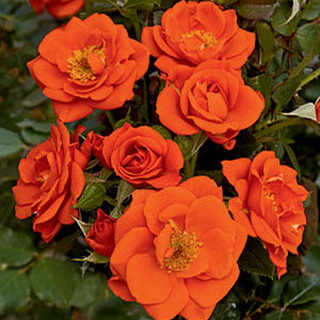
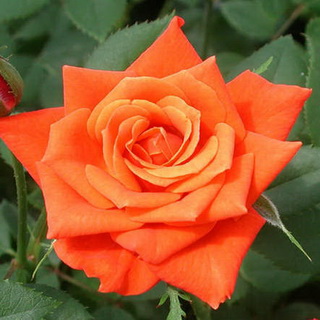
Dark orange classic rose with flowers 4-5 cm in diameter. Especially decorative, due to the intense color of the flowers. Abundant flowering. Bush height: 30-40 cm.
Rapidly lignified shoots grow straight, each forming up to 80 flowers. Leaves are compound, 5-7 leathery, shiny leaves, ovoid, finely serrated along the edge, in most varieties they are dark green, but there are varieties with bronze-brown foliage or light green with dark veins. The flowers are small with a lot of petals.
They do not retain their color during the flowering period: the bush simultaneously has lemon-yellow, coral-pink, crimson-crimson flowers, which makes the plant exceptionally elegant.
"Clementine"
The diameter of the flower is 5 cm.
As you can see in the photo of this variety of decorative roses, the shade of the flowers changes surprisingly beautifully from pink to apricot orange:
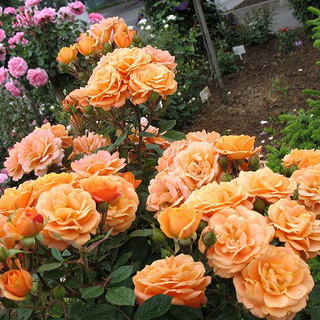

The height of the bush is 40-60 cm. The bushes are compact, strong. The distance between plants is 30-35 cm. The variety is resistant to powdery mildew and black spot. Repeated flowering. It is especially recommended to grow in small rose gardens.
In temperate zones, the buds do not bloom for a long time, in half-release they have the form of noble large-colored roses. In hot conditions, the buds are emitted on the 4th-5th day and the whole mouth is covered with bright beautiful flowers throughout the summer. Cut flowers stand in water for 7 - 9 days without losing their decorative effect; in some varieties they have a delicate aroma.
"Hummingbird"
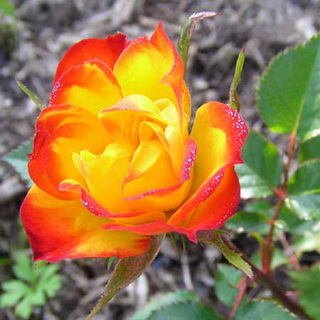
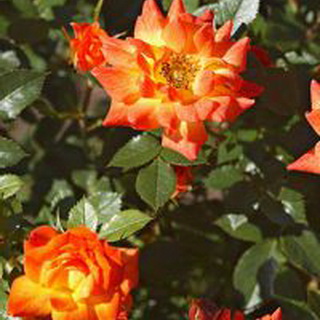
Abundantly blooming rose 25 - 30 cm high with flowers up to 3 cm in diameter. Flowers are yellow-orange, slightly double, with original petals spread out like hedgehog thorns. The color fades in the sun. Leaves are shiny, leathery.
"Jewel"
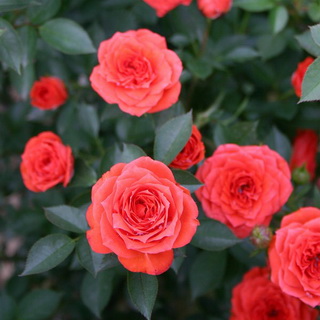

The buds are oval, pointed. The petals are dark red, with a yellow bottom, when flowering they bend down, fade slightly. A flower with a high center, medium (3-5 cm), densely double (up to 100 petals), slightly fragrant.
Develops in small inflorescences and singly, on thin, strong peduncles. Leaves are elongated, dark green, leathery, shiny, young leaves and shoots are dark red. Thorns are rare. The bushes are compact. Moderate flowering throughout the season. Flowers persist for a long time.
"Lavender"

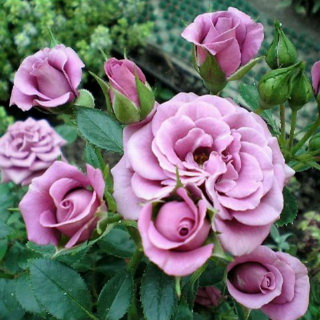
At first, they are shaped like a hybrid tea rose, but when they open, they look like a miniature floribunda. The color is beautiful, pure, lavender, with shades of lilac and lilac. The number of flowers on the stem is 1 - 3 pieces. The size of the flower is 4-5 cm in diameter. The height of the bush is no more than 40-50 cm.
They can also decorate walls, balconies, and decorate arches.
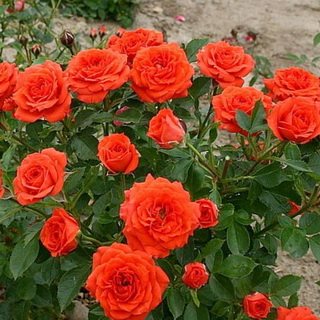
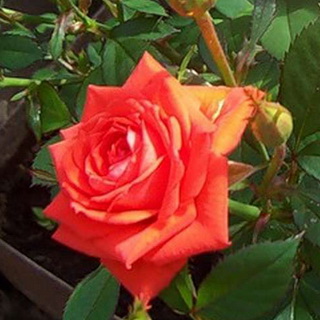
"Orange Jewel" - salmon-orange flowers, large, densely double, noble shape, do not fade for a long time. The bush is strong, compact, grows easily. Height 30 cm.
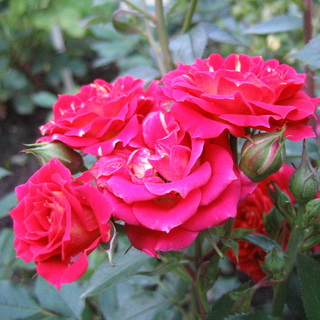
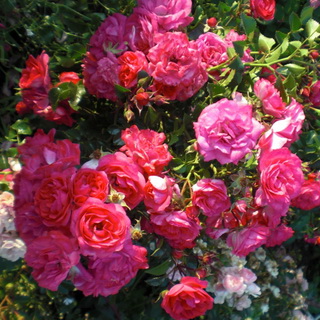
"Amulet" - flowers of rich pink-red color, large, densely double. The foliage is green. The bush is dense, fast growing, healthy. This variety is renowned for its charming flowers and abundant and long-lasting flowering. Height - 50 cm.
Look at the photo - miniature roses look very decorative:

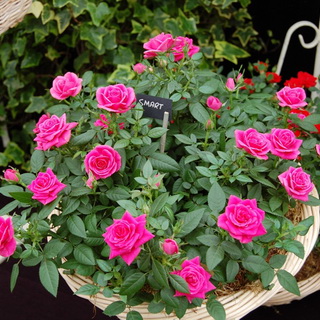
The following are considered the best varieties of miniature roses today:


"Little Baccarat" is a low (up to 25 cm) bush, spreading. The leaves are shiny with a bronze tint. Semi-double flowers, redcrimson with white center... They have a pleasant scent.
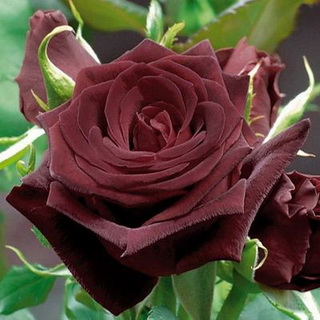
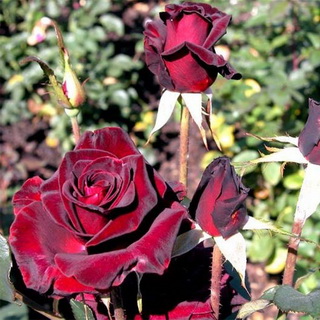
"Baby Baccarat" - are distinguished by the ideal shape of the flower, velvety red, almost black.

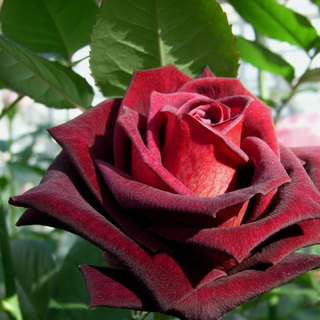
"Pomegranate" is a densely leafed, durable bush, a shiny, dark leaf, abundant flowering. The flowers are large (up to 5 cm in diameter), perfectly shaped, crimson-red.

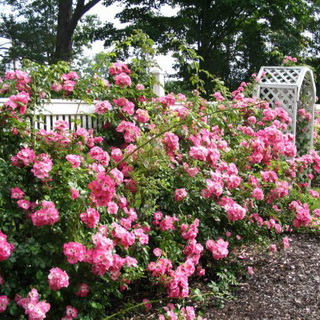
"Rosemary" - with light silvery pink flowers and a red eye in the center.
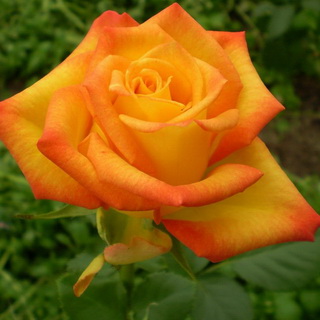

"Old" - with small double flowers of orange color.
Varieties of pink roses
A variety of pink roses also known as "landscape" species. This type has been developed to satisfy the desire for garden vegetation that offers color, shape and fragrance, but is also easy to care for.
They tend to reach a maximum height of three feet, although some grow as tall as normal ones and tend to be wider. They often get sick. However, this species is very resistant to pests, repetitive flowering and is easy to care for.
Aqua.It is a beautiful class among all flowering plants. The fact is that it is the fruits of this class that have a non-standard image. Namely, the petals at the tip are curved, creating an unusual and interesting look. The flowers themselves have a pale pink color, the flowering time is all summer, and the fruits themselves are very strong and hardy.
Aquarell. An unusual look, where several colors are combined - from light pink to peach. Large petals and extraordinary shape make this flower a wonderful decoration for any garden. Resistance to frost, rain and harmful insects - low. It's blooming time - all summer.
Titanic. One of the most interesting and unusual types among the great variety is the Titanic. The fact is that its size can reach incredible dimensions. Because of its size, this flower was named after the Titanic of the same name, which was also huge in size.
These are large pink flowers with shades of cream. Despite the fact that they are considered photophilous, the Titanic should not be planted where there is a lot of sun. These types are more prone to shaded areas.
Engagement. These are soft coral flowers that have a standard glass shape, however, the petals of such a plant are not the most ordinary ones. The fact is that at the edges they bend, creating an unusual hermetic shape. Tolerance to insects and rain is average. Flowering time - several times per season.
Beautiful roses by David Austin
The famous breeder from England David Austin experimented for many years to create the unusual beauty of roses. In his numerous studies, he used several types of plants (bourbon, floribunda, tea and some varieties of French roses). In his deepest dreams, the goal was to combine modern colors and continuous flowering without losing the classic beauty inherent in roses. And this dream became a reality, which made it possible to position his varieties in a separate group - Austin roses (Ostinki). The colors are dominated by shades of peach, red, apricot, yellow.
The ostins have very beautiful, compact, powerful bushes, on which abundantly flowering large-flowered inflorescences are located. The diameter of each bud reaches about 13 cm. The petals are double and do not fade in the sun, delighting people for a long time with their indescribable beauty.
The flowering of the most beautiful varieties of roses (see photo) bred by David Austin takes place in waves, but the break between these periods is small (about 14 days). The height of each bush reaches a meter in height. This makes them very attractive.
Beautiful varieties of roses (photo with names):
- Beveler (Beveler).
- Artemis (Artemis).
- L. D. Braithwaite
- Summer Song.
- Queen of Sweden
- Crocus Rose
- The Mayflower (Ze Muyflauer).
- Munstead Wood (Mounstead Wood).
- Grace (Grace).
- Susan Williams-Ellis
- Tea Clipper (Tea Clipper).
- Gertrude Jekyil
- Crown Princess Margareta
Austin's most fragrant roses:
- The Mayflower (Mayflyep).
- Gertrude Jekyll (Gertrude Jekyll).
- William Shakespeare 2000 (William Shakespeare 2000).
- Munstead Wood
- Susan William-Ellis
- Falstaff (Falstaff).
The most beautiful varieties of roses with abundant flowering:
- Ave Mariya
- Super Excelsa (Super Excelsa).
- Alan Titchmarsh (Alan Titchmarsh).
- Christopher Marlowe (Christopher Marlowe).
- Bylina (Epic).
- Viola (Viola).
- Missis John Laing (Mrs. John Laing).
The most beautiful roses (photo) with two-tone, saturated shades:
- Kleine Rosel Bright yellow stamens are surrounded by reddish-purple flowers.
- Apple Blossom (Apple Blossom). The petals with pale pink tips have the characteristic luster of apples.
- Evangeline Beautiful light flowers, the petals of which have red edges.
There are also varieties of beautiful roses that can form flowers on the same shoots for up to 3 years:
- American Pillar (American Pillar).
- General Testar (General Testar).
- Unkle Walter
- Evangelina (Evangelina).
- Fragecajhen (Fragezeichen).
Varieties and photos
Blushing bride
Climbing rose variety capable of growing up to five meters. Flexible stems are covered with dense, dark green, healthy foliage. Flowers, white with a cream shade, are collected in lush inflorescences. Long-lasting flowering throughout the season.
The aroma is not pronounced, the plant has a high degree of disease resistance, great for decorating gazebos, arches, fences. Winters well under cover.
Alexandre girault
A climbing rose hybrid, reaching a height of 3.5 - 5 m. It has a small number of thorns. The foliage is glossy, dark green in color. Flowers, carmine-pink saturated shade, flowers have curved petals and reach 5-6 cm in diameter. Appearing in abundance on the bush, they fill the garden with a rich fruity aroma.
Due to its tallness, this variety is successfully used to decorate gazebos or any vertical surfaces. The plant has an average degree of resistance to disease and rain, tolerates shade, requires winter shelter.
Banksiae Banksiae
Belongs to the group of small-flowered climbing roses. It reaches a height of 4-7 meters, the shoots are flexible and practically devoid of thorns. The leaves are elongated, shiny. Early and abundant flowering. Small white-cream flowers with a characteristic violet scent, collected in large inflorescences. The plant is weakly hardy and needs good shelter.
Wartburg
The variety belongs to the group of multiflora hybrids. A vigorous bush has smooth shoots without thorns. Raspberry pink, small, double flowers, no more than 2 cm in diameter, collected in 35-40 pieces in large, inflorescences. Abundant flowering, one-time, for 25-30 days.
Heritage
The flowers are dense, heavy, pastel pink in color. The plant can reach one and a half meters in height. With proper care, the bush is almost not bare from below, expands upward and is quite spreading.
Lush foliage and elongated shoots are formed around the third year of the plant's life. The foliage is dark green, large, the shoots are practically devoid of thorns. The variety is resistant to precipitation, blooms only in sunny areas, does not tolerate even a light shade.
Mme alfred carriere
Belongs to the group of noisette roses. This old variety can grow up to five meters, has half-leafy, thornless shoots. Flowering begins early, throughout the season the plant pleases with large pale pink flowers with a delicate aroma. Poorly tolerates cold, requires very careful shelter for the winter.
Maria Liesa
Tall variety, can reach three meters. The plant is powerful, with strong shoots practically without thorns. Leaves are dark green, small, pointed, glossy. Flowering is long, single.
Cup-shaped, double, crimson-pink flowers with a white center and yellow stamens are collected in inflorescences. The plant perfectly survives precipitation and frost down to -25 degrees.
Marie-jeanne
Belongs to the group of low polyanthus roses, the height of the plant does not exceed one meter. The bush is compact, practically without thorns. The foliage is dense, round, dark green in color. Small white flowers bloom in lush inflorescences at the ends of the shoots. The aroma is medium. The shrub is resistant to diseases, hibernates under cover.
Crimson Rambler
Differs in intensive growth, as a result of which, it is able to quickly braid surfaces. On average, the plant is 4 meters tall.
The flowers are small, up to 5 cm in diameter, fiery carmine-red in color, collected in inflorescences of 40-50 pieces. Flowering is single, lasts a little more than a month. The plant is odorless. In the presence of shelter, it calmly tolerates frosts down to -30 degrees.
Coat of arms rose
Vigorous, up to four meters, a hybrid of a climbing rose, blooming throughout the season with bright pink fragrant flowers, collected in inflorescences of 3-5 pieces. Shoots with sparse thorns and dark green shiny leaves. The plant tolerates partial shade, has an average degree of resistance to rain and disease.
Paul Trenson
A fast growing rose with salmon pink flowers similar to pompons. The first wave of flowering is very abundant, after which individual flowers bloom throughout the season. The shoots are flexible, almost without thorns, covered with light green foliage.The plant can reach a height of three meters, endures partial shade, has an average degree of resistance to powdery mildew and black spot.
Beautiful roses of the Topalovich brothers
In all corners of the world, with great diligence, many growers are engaged in the cultivation of scrub roses. The word "shrab" in translation from English means "bush". Therefore, it is not difficult to guess what it is about. Shrub roses are very popular as they are grown commercially. But in many summer cottages you can see shrub roses that adorn flower beds and flower beds.
In Serbia, there is a very popular and one of the best nurseries in Europe, which grows beautiful varieties of roses (see photo), and it is named after the Topalovic brothers. Its history begins in 1931. Despite many difficulties, primitiveness has been preserved in it, which is now combined with innovative approaches to breeding beautiful species of roses. As a result of their activities, many exotic varieties have been bred. The nursery "Brothers Topalovich" for the entire period of its breeding activity has received many awards and recognition in many countries of the world.
Many experts note good resistance to cold weather and absolute immunity to some pests (aphids, locusts).
What is the most beautiful variety of roses? The most popular are:
- Bleck Bakkara
- Blue Nil
- Simsabella (Simsabella).
- Fitja Negra (Fitja Negra).
- White Bear.
- Blaje
- CoolWater (Cold Water).
Despite the many advantages, these roses require careful, painstaking and attentive care.
Agrotechnical measures and care
Each of the varieties of roses has its own advantages and disadvantages. In addition, the culture is distinguished by special planting and care rules. You can get a colorful, fragrant crop of flowers, provided you follow the growing recommendations, which do not require much effort. Let's consider the main ones related to specific species.
Miniature roses can be planted outdoors, in pots or containers. They tolerate frequent transplants. Flowering occurs three times a year. Small bushes are overgrown with bright orange buds. Plants growing in beds in winter need special shelter. But it is also allowed to grow at home or on balconies.
When planting hybrid tea species, most of the buds should be removed to build a powerful root system. It is better to plant flowers away from trees, whose foliage will block access to light
Some varieties of roses are not resistant to disease, so timely processing is important. With the onset of the first cold weather, the beds should be earthed, covered with spruce branches.
Floribunda needs a dry, well-lit place
You should choose the soil without the occurrence of nearby groundwater. The first pruning occurs in early autumn - it involves shortening thin or diseased branches. The second procedure is carried out in the fall - here they get rid of old shoots. Care involves moderate watering, winter shelter.
Planting material should be purchased in specialized garden / summer cottages or from trusted professional gardeners. It is preferable to choose seedlings in plastic containers - such samples are distinguished by their quick survival in the ground. Open options should be carefully examined - there should be no rot, spots on the roots. Any damage indicates improper storage or transportation conditions. Such goods should be discarded. A suitable method of disembarkation is the transshipment of an earthen clod. After about two weeks, young roots begin to form in the soil, turning into a whole living system, from which a lush bush subsequently forms.
As for care, it includes spring, summer, autumn works. So, in the last days of March, orange roses should be freed from winter shelter. In case of cold weather, the procedure is postponed for a month.Do not forget about preventive work against harmful insects and plant diseases.
An important care procedure is pruning, weeding, loosening the soil. Rose bushes need a support that supports and also protects the branches
Wooden sticks are set in the ground, to which roses are tied.
Summer is the time of the first flowering. Experienced gardeners recommend reprocessing the plant against disease. It will be useful to get rid of withered buds. Mandatory procedures during this period are watering, weeding, loosening the soil.
Preparation for wintering begins in the fall. At this time, there is no need for feeding, but you need to remove a third of the leaves - especially at the base of the bush. With the arrival of the first frost, sanitary pruning is carried out. In the last days of October, you should take care of the shelter - the plants should be well insulated for the winter. Experts advise, after the first snowfall, to compact the place near the bushes with snow - this way you will save the culture from rodents.
Orange roses are a real decoration of any local area. Despite the uniqueness of the color and smell of the flower, planting material can be easily found in specialized stores. All roses, without exception, need proper planting and subsequent care.
According to experienced gardeners, you should not overfeed the plant with mineral or organic fertilizers - it is important to know when to stop. Only by following all the rules of agricultural technology, you can observe lush bushes with bright orange buds in the garden, which emit a pleasant light aroma
You will learn how to properly prune roses in the following video.
Let’s block ads! (Why?)


